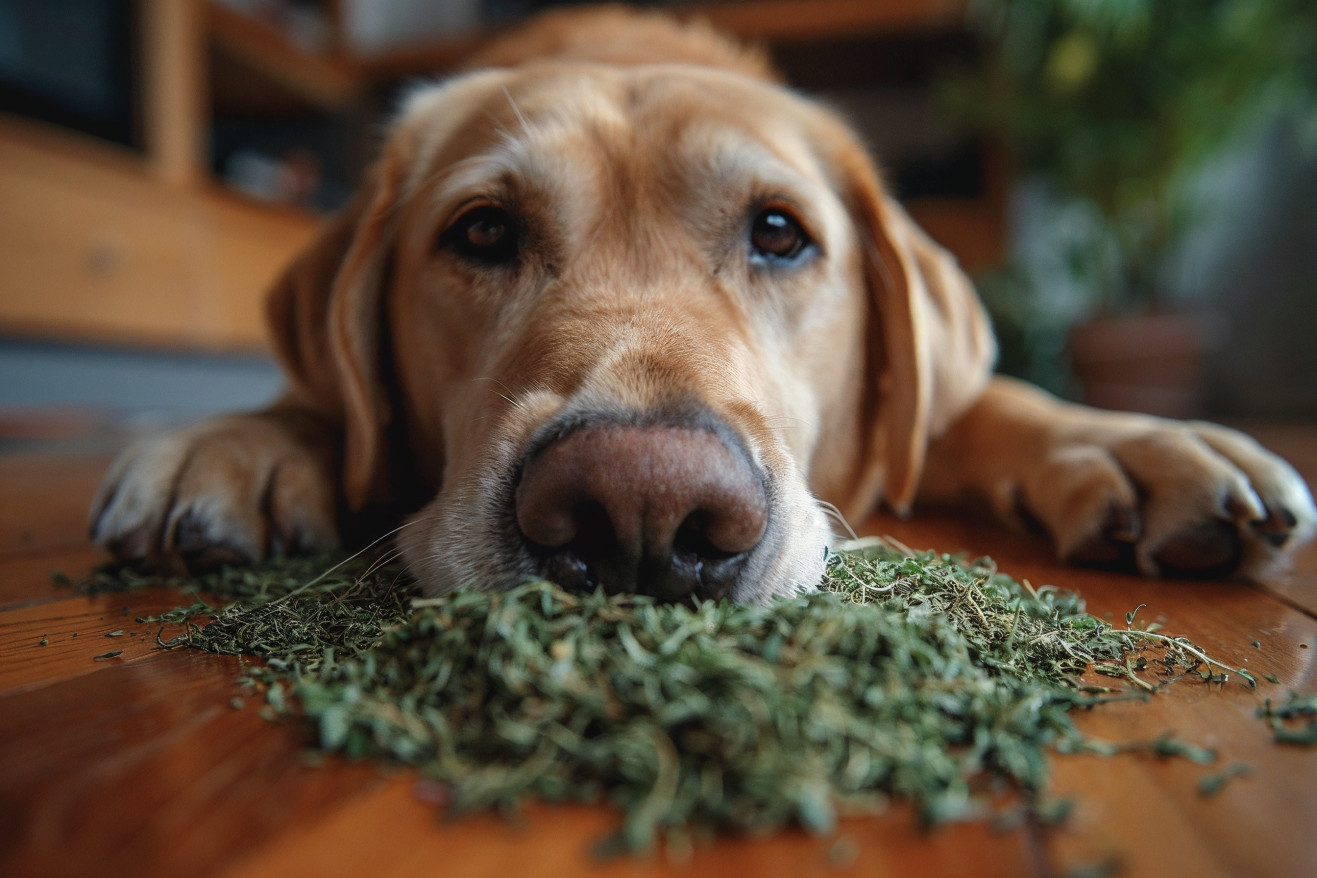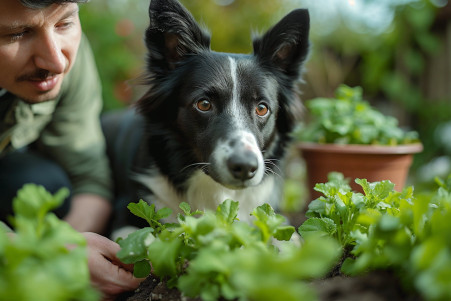Can Dogs Get High From Catnip? Here's Why the Effects Are Species-Specific
12 June 2024 • Updated 11 June 2024

Even though catnip is well-known for its mind-altering effects on cats, you might be wondering if it has any impact on dogs. However, dogs can't get high from catnip because they lack the olfactory receptors that are sensitive to the active compound nepetalactone in catnip. As a result, while catnip is safe for dogs, it will likely just smell like another plant and won't have any effect on them.
In this article, we'll look at the research on this topic to see why the effects of catnip are so specific to cats and don't affect dogs. We'll look at research in a number of fields, including biology, chemistry, and animal behavior, to see why this is the case. By learning about the physiological differences between the two species, you'll learn more about how they're adapted to their environments and how they perceive the world.
Can dogs get high from catnip?
The Unique Physiology of Cats and Dogs: Why Catnip Doesn’t Affect Dogs
The unique physiology of cats and dogs holds the answer to why catnip has such different effects on the two species. Cats have a special scent organ called the vomeronasal organ that is particularly sensitive to the nepetalactone in catnip. This compound, according to Dr. Tina Wismer of the ASPCA Animal Poison Control Center, is similar to the pheromones that female cats release when they’re in heat, which is why it causes the behaviors we associate with a cat’s reaction to catnip.
On the other hand, dogs have vomeronasal organs and more than 100 million scent receptors, but they don’t have the receptors that would allow them to detect and respond to nepetalactone. This difference in their biology is why catnip doesn’t have the same effect on dogs.
The reason for this difference in the two species’ evolution likely has to do with the roles that cats and dogs played in their ancestral environments. As solitary hunters, cats needed to be able to detect pheromones and compounds like nepetalactone to help them find mates and protect their territories. Dogs, on the other hand, were pack animals that were more social and therefore relied less on chemical signals to help them find mates.
So, while catnip is just another plant to dogs, this example shows how different species have evolved to interact with their environments through their biology. Understanding these differences can help us understand the diversity of life.
Health Benefits of Catnip for Dogs
Even though catnip doesn’t have the same psychoactive effects on dogs as it does on cats, studies have shown that it can still have some health benefits for our furry friends. According to Everything You Need To Know About Catnip & Dogs, catnip is rich in magnesium, vitamin C, and vitamin E, all of which can help with cognitive function and joint health in dogs.
The MetLife Pet Insurance article also notes that catnip’s sedative properties could have potential applications for helping with anxiety in dogs, although more research is needed. Meanwhile, The Canine Nutritionist explains that catnip is a natural sedative for dogs, which can help with anxiety and nervousness. It can also be used to prevent travel sickness and aid digestion.
Moreover, Animal Wellness Magazine says that catnip’s essential oil, nepetalactone, is ten times more effective than DEET at repelling mosquitoes, so it can be used as a natural insect repellent for dogs. Veterinary professionals have recommended catnip as a safe, natural way to help dogs relax in stressful situations.
How to Give Your Dog Catnip and Dosage Information
PetHonesty lists a few ways to give your dog catnip, including sprinkling dried catnip on their food, adding fresh catnip leaves to their water, and using fresh catnip on minor cuts and scrapes. Two Tails Pet Company recommends giving dogs 1/8 to 1/2 teaspoon of dried catnip at a time.
Because catnip should not be given to dogs every day, it’s important to use it in moderation. As a result, according to Healthy Paws Pet Insurance, the best way to use catnip with dogs is to give it to them about 30 minutes before a stressful event like a car ride, fireworks, or bedtime so that it has time to take effect. This way, you can ensure that your dog experiences the calming effects of catnip. With this in mind, you can give your dog catnip in a way that’s safe and that will help them feel more relaxed.
Potential Risks and Side Effects of Catnip Overconsumption in Dogs
Although catnip is generally safe for dogs, it’s important to understand the potential risks and side effects of overconsumption. According to Spot Pet, overconsumption of catnip can lead to vomiting or diarrhea in dogs. However, the experts say that it is unlikely for a dog to overdose on catnip.
That being said, Nom Nom warns that catnip can have negative effects on dogs, especially older dogs, if consumed in large amounts. Symptoms of a catnip overdose can include extreme sleepiness, lack of energy, and stomach issues. In addition, pregnant dogs should not have catnip because it can cause uterine contractions and induce labor, according to PetsRadar.
To avoid any potential problems, FOTP advises pet parents to introduce catnip to their dogs slowly and cautiously, starting with a small amount (1/4 teaspoon) and observing their dog’s response. If you notice any negative side effects, stop giving your dog catnip and contact your vet right away. As with any new supplement or herb, it’s a good idea to talk to your vet before giving your dog catnip, especially if they have any underlying health issues.
Catnip and Dogs: Myths, Misconceptions, and Expert Insights
Despite the fact that catnip is safe for dogs, there are several myths and misconceptions that dog owners should know about. For example, Rover notes that one myth is that catnip has the same euphoric effect on dogs as it does on cats. However, as the experts at Animal Care Clinic point out, dogs don’t have the olfactory receptors that are sensitive to the nepetalactone compound in catnip, so they don’t have the same kind of response to it.
Although catnip is safe for dogs to eat, PetsRadar warns that it shouldn’t be given to pregnant dogs because it can cause uterine contractions and induce labor. In addition, dogs with certain health conditions, such as heart disease and urinary tract issues, may be more sensitive to the side effects of catnip, which can include increased urination and digestive upset.
There’s not a lot of ongoing research in this area, but experts like those interviewed by The Wildest are still working to better understand how catnip affects dogs. As a result, as we learn more about the relationship between catnip and dogs, dog owners will be able to better determine whether or not they want to give their pets this herb.
Conclusion: Understanding the Unique Relationship Between Catnip and Dogs
While catnip is famous for its intoxicating effects on cats, it does not produce the same euphoric response in dogs. This is due to fundamental differences in the physiology of the two species, particularly in their olfactory receptors and vomeronasal organs.
The research presented in this article has explored the potential benefits and risks of introducing catnip to dogs. While catnip may offer some mild calming or sedative effects, it is important to use it in moderation and under the guidance of a veterinarian, especially for dogs with underlying health conditions.
Ultimately, the unique relationship between catnip and dogs highlights the profound ways different species have adapted to interact with their environments. As our understanding of this dynamic continues to evolve, further research will be crucial in unlocking the full potential of this herb for our canine companions.


